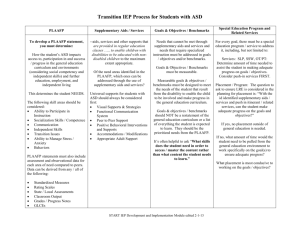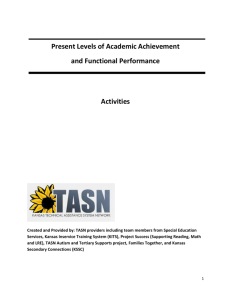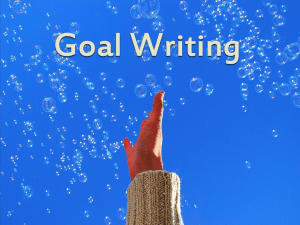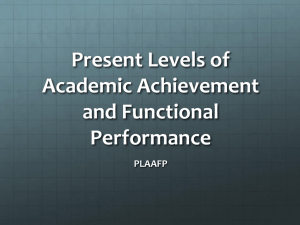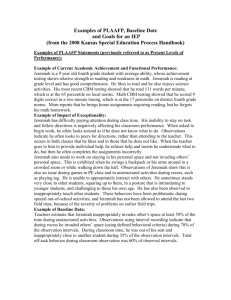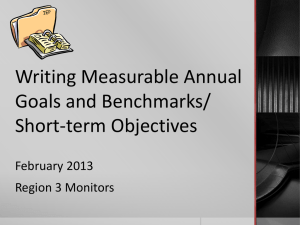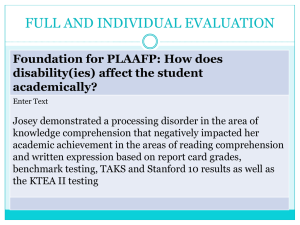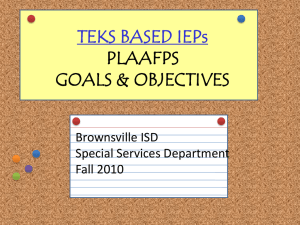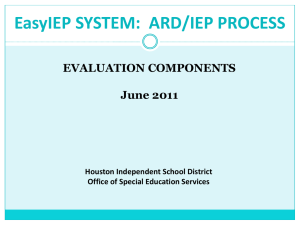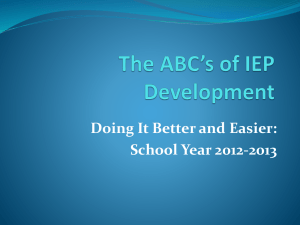RefresherForPLAAFPs - Weatherford Independent School District
advertisement
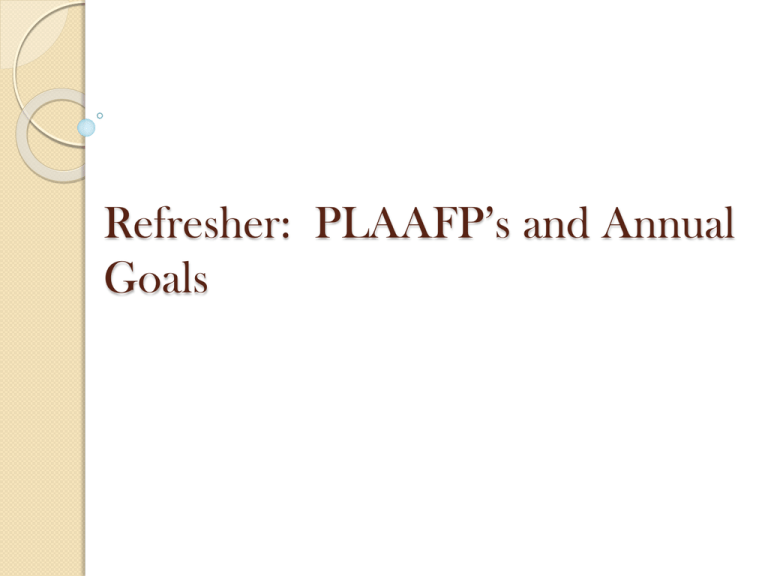
Refresher: PLAAFP’s and Annual Goals IDEA §300-320 Requires ARD committee to include measurable annual goals, including academic and functional goals For students who take alternate assessments aligned to alternate achievement standards (TAKS-Alt), requires both annual goals and short-term objectives Requires appropriate measureable postsecondary goals beginning with the first IEP in effect when the student reaches the age of 16. It All Starts with the Present Levels of Academic Achievement and Functional Performance (PLAAFP) What is it? A summary statement which describes the student’s current academic achievement and functional performance in the areas of need as determined by evaluation. What is the purpose of the PLAAFP? To identify and prioritize specific needs of a child To establish baseline performance in the general curriculum which is used to develop individualized, meaningful and measureable goals. To identify how the disability affects performance. Academic Achievement (PLAAFP) focuses on what specific kinds of academic information and skills you child has mastered . (examples: reading at a certain grade level, or performing certain mathematical calculations). Functional Performance (PLAAFP) refers to other areas of achievement that are not academic. (examples: social skills, communication skills, and other activities of daily living.) The PLAAFP is the foundation on which the ARD committee will write goals for the student’s educational year. Objectives/Benchmarks Measurable annual goals Present Levels of Performance PLAAFP Components Data based student specific information about current academic performance Data based student specific information about current functional performance Strengths of student (academic or functional dependent upon target area) Need(s) resulting from the disability (academic or functional dependent upon target area) Note: Any academic or functional need listed in PLAAFP must be addressed in the Annual Goals. Effects of the disability on involvement and progress in the general education curriculum. Can What the student can do before the intervention – Data based and specific strengths (academic and functional). Include any conditions that are required for student to show strength. Can’t/ Doesn’t What the student can’t or doesn’t do that needs intervention; Data based needs resulting from disability (academic and/or functional) Prioritized needs Impact How the skill the student can’t do effects involvement and progress in the general education curriculum. * Functional impact – how skill the student can’t do effects how he functions in real world. Example: Can According to DRA and benchmark assessment, Ophelia’s instructional level in reading is 6th grade. She can fluently read 130 wpm with 90% accuracy at this level and can correctly answer more than 70% of factual information comprehension at the sixth grade reading level. Using graphic organizers and with oral assistance, she can answer more than 70% of factual information questions on grade level text in science and social studies. Can’t/ Doesn’t Ophelia is only able to answer 40% of inferential questions based on benchmark testing. She participates in class but often requires up to two reminders to turn in her work. She requires graphic organizers and organizational skills to be successful in the general education classroom. Impact Her difficulty in reading comprehension inhibits her progress with assignments in all subjects that require independent grade-level text reading and comprehension. Her lack of organizational skills makes it difficult for her to keep up with assignments. Where can you find data? Performance Series Running Records Reading Logs DCA’s Student Work Samples Sight word lists Chapter tests Teacher made tests Previous attained IEP objectives Hands – on performance DRA and TPRI Psychological /Related services evaluations Parent / Teacher Input Anecdotal Records Progress Monitoring Benchmarks State assessments Student Journals Rubrics Portfolios Activity 1. With a partner review the PLAAFP examples and determine which components, if any are missing. 2. Rewrite any PLAAFP that is missing components. Be prepared to share. 10 Minutes Once the PLAAFP is written – it’s time for the Annual Goal What is it? A statement that describes what a child with a disability can reasonably be expected to accomplish within a twelve-month period in the child’s special education program. There is a direct relationship between the PLAAFP and the annual goal. Measurable Annual Goals must: Be related to meeting the child’s needs (academic /functional) that result from the disability to enable him/her to be involved in the general curriculum. Annual Goal Components Timeframe Identifies the amount of time in the goal period and is usually specified in the number of weeks or a certain date for completion. For example, “within 36 instructional weeks” Conditions Specify the manner in which progress toward the goal occurs. Conditions describe the specific resources that must be present for the child to reach the goal. The condition of the goal should relate to the behavior being measured. For example, a graphic organizer could be a condition. Behavior Clearly identifies the skill or performance that is being monitored. It represents an action that can be directly observed and measured. For example, “points to the yellow object” could be a behavior. Criterion Identifies how much, how often, or to what standard the behavior must occur in order to demonstrate that the goal has been achieved. The goal criterion specifies the amount of growth that is expected. For example, “in 7 out of 10 trials” might be a criterion. Relationship between PLAAFP and Annual Goal PLAAFP Data: Stephanie is a ninth grade student whose strengths include excellent listening comprehension skills; ability to use teacher-generated outlines and study guides to comprehend text and lectures. She depends on study guides and outlines to locate information for science and social studies classes. Ongoing progress monitoring measures Stephanie reading 100 words a minute with 3-5 errors on grade level materials. Her slow fluency effects her overall reading comprehension and her ability to complete assignments in the general ed. classroom. Annual Goals: Within 36 instructional weeks, given grade level science and social studies text, Stephanie will read at a fluency level of 135 wpm with 0-3 errors, as measured by timed oral reading of grade level science and social studies text. Relationship between PLAAFP and Annual Goal PLAAFP Data: Based on teacher and district benchmark assessments, Sylvia can add and subtract two and three digit numbers without regrouping, without the use of manipulatives, 100% of the time. She understands only ones place value. Sylvia (grade 5) lacks the understanding of place value and regrouping in both addition and subtraction, therefore inhibiting her progress in the general curriculum. Annual Goals: Within 36 instructional weeks, using manipulatives , Sylvia will use place value to read, write, compare and order whole numbers through the ten thousands place with 90% accuracy. Annual Goals: Is another goal needed based on PLAAFP? The Stranger Test Goals written in a fashion where anyone unfamiliar with the child could read it and follow it. The goal leaves no room for interpretation. You Make the Call Within 36 instructional weeks, given 100 high frequency spelling words, Darleen will correctly spell 75/100 words, 4 out of 5 times tested. Timeline Condition Behavior Criteria You Make the Call In 36 instructional weeks, Barbara will use proper conventions addressing the mechanics of writing, including capitalization, punctuation, spelling, grammar and usage, paragraph breaks, and legibility with 1-2 verbal cues. Timeline Condition Behavior Criteria You Make the Call Given 5 – three digit X three digit multiplication problems with regrouping, Mariah will multiply to determine the correct product with 100% accuracy in 4 of 5 opportunities, but the end of the sixth six weeks. Timeline Condition Behavior Criteria Rules to Remember ** Goals which use participation as criteria or focus on a onetime event are not appropriate. Johnny will participate in the field trip on Thursday. ** Annual Goals must reflect observable behavior that can be objectively measured. Examples: read, name, write, solve Non- examples: increase, know, understand **Goals are not measurable if they do not contain objective conditions and criteria for success. Thomas will improve his communication skills. Taylor will engage in problem solving with 85% accuracy. **Measurable annual goals must be based on appropriate standards. Two year old Sarah, will count from 1 to 100 with 80% accuracy Be Careful of Percentages If you say a student will do something 80% of the time…80% of what? A 24 hour day? Must state accountability. 80% of 15 minute period, 80% of writing assignments, etc. Using a percentage alone does not mean measurable. Misuse of Percentages Example: Levi will exhibit acceptable behavior 80% of time. ◦ Imagine what it would be like to be around a child whose behavior was unacceptable 20% of the time. Q &A Work Session
